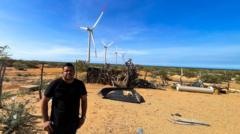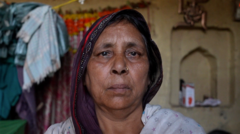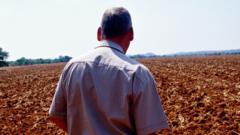As Colombia shifts towards renewable energy, indigenous communities face both opportunity and disruption from wind farms.
**Indigenous Concerns Rise Amidst Colombia's Wind Energy Expansion**

**Indigenous Concerns Rise Amidst Colombia's Wind Energy Expansion**
Colombia's wind energy transformation presents challenges for the Wayuu people as their cultural ties clash with renewable energy projects.
In La Guajira, Colombia, the quiet landscape dotted with towering wind turbines has become indicative of the country's transition towards renewable energy sources. Yet, for José Luis Iguarán, reflecting the sentiments of the Wayuu indigenous group, this transition raises profound questions about cultural integrity and environmental impacts. While the region, known for its strong winds, is harnessed for energy generation, it paradoxically disrupts the very essence of the Wayuu's spiritual connection to nature.
"Every morning, the sight of spinning turbines replaces the trees we once knew," says Iguarán, as he discusses his community's mixed feelings about the Guajira 1 wind farm. The sound generated by the turbines isn't just noise; it disturbs their sacred dreams, a vital aspect of their cultural identity rooted deeply in ancestral beliefs.
The Wayuu community, which numbers approximately 380,000 and extends into Venezuela, has a long history of agricultural and subsistence practices. With the construction of Guajira 1, which enjoys the backing of Colombian firm Isagen—owned by Canada's Brookfield—there have been some improvements like access to clean water and better infrastructure. However, these benefits come amid significant cultural upheaval.
Various local villagers, including fisherman Aaron Laguna, express concerns about the encroachment of wind projects. "The wind farms bring energy but also division among us," he states, pointing to the lack of transparency and adequate compensation in negotiations regarding the land. The fear of growing disparities and cultural disrespect has led some within the community to voice dissent against the projects, fearing that only a select few benefit from the developments.
The discontent towards multinational energy firms is echoed by Joanna Barney of the think tank Indepaz, which has researched the social repercussions of energy transitions in Colombia. The absence of robust legal frameworks to evaluate the social and environmental effects of these energy projects complicates matters, leading to conflicts and disillusionment among local communities.
The situation is further complicated by recent withdrawals from investment ventures in La Guajira, including EDP Renováveis and Enel, prompted by local opposition and protests. Instances of unrest, including roadblocks and violence, highlight the challenges of enacting green initiatives without satisfactory resolutions to community grievances.
Anthropologist Wieldler Guerra emphasizes the cultural rift between the Wayuu people and the energy companies. "Both sides live in different realities," he notes, underscoring the Wayuu belief in multiple winds as respected entities, contrasting sharply with the companies' view of wind as a mere resource for profit.
Despite companies like AES Colombia expressing commitments to dialogue and fair compensation, local communities still grapple with a pressing challenge: they remain disconnected from the benefits of the energy they help produce. La Guajira, still lacking basic services such as education and clean water, faces an uncertain future where the energy harnessed from its winds perhaps won't alleviate these pressing needs.
Reflecting on the aspirations for renewable energy, residents like Laguna carry a heavy burden of contradiction. "We will not benefit from the electricity produced here," he laments, pointing to a future that may provide energy resources elsewhere while leaving local communities reliant on generators.
As Colombia navigates the complexities of its green energy evolution, the voices and rights of indigenous communities remain a crucial dialogue in ensuring that the ambition for progress includes all stakeholders.
"Every morning, the sight of spinning turbines replaces the trees we once knew," says Iguarán, as he discusses his community's mixed feelings about the Guajira 1 wind farm. The sound generated by the turbines isn't just noise; it disturbs their sacred dreams, a vital aspect of their cultural identity rooted deeply in ancestral beliefs.
The Wayuu community, which numbers approximately 380,000 and extends into Venezuela, has a long history of agricultural and subsistence practices. With the construction of Guajira 1, which enjoys the backing of Colombian firm Isagen—owned by Canada's Brookfield—there have been some improvements like access to clean water and better infrastructure. However, these benefits come amid significant cultural upheaval.
Various local villagers, including fisherman Aaron Laguna, express concerns about the encroachment of wind projects. "The wind farms bring energy but also division among us," he states, pointing to the lack of transparency and adequate compensation in negotiations regarding the land. The fear of growing disparities and cultural disrespect has led some within the community to voice dissent against the projects, fearing that only a select few benefit from the developments.
The discontent towards multinational energy firms is echoed by Joanna Barney of the think tank Indepaz, which has researched the social repercussions of energy transitions in Colombia. The absence of robust legal frameworks to evaluate the social and environmental effects of these energy projects complicates matters, leading to conflicts and disillusionment among local communities.
The situation is further complicated by recent withdrawals from investment ventures in La Guajira, including EDP Renováveis and Enel, prompted by local opposition and protests. Instances of unrest, including roadblocks and violence, highlight the challenges of enacting green initiatives without satisfactory resolutions to community grievances.
Anthropologist Wieldler Guerra emphasizes the cultural rift between the Wayuu people and the energy companies. "Both sides live in different realities," he notes, underscoring the Wayuu belief in multiple winds as respected entities, contrasting sharply with the companies' view of wind as a mere resource for profit.
Despite companies like AES Colombia expressing commitments to dialogue and fair compensation, local communities still grapple with a pressing challenge: they remain disconnected from the benefits of the energy they help produce. La Guajira, still lacking basic services such as education and clean water, faces an uncertain future where the energy harnessed from its winds perhaps won't alleviate these pressing needs.
Reflecting on the aspirations for renewable energy, residents like Laguna carry a heavy burden of contradiction. "We will not benefit from the electricity produced here," he laments, pointing to a future that may provide energy resources elsewhere while leaving local communities reliant on generators.
As Colombia navigates the complexities of its green energy evolution, the voices and rights of indigenous communities remain a crucial dialogue in ensuring that the ambition for progress includes all stakeholders.





















